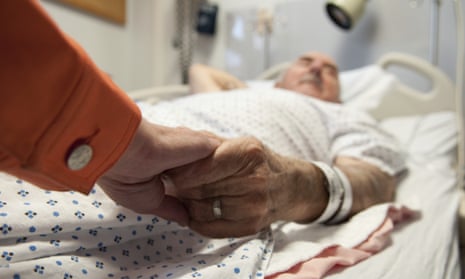More than 40% of hospitals offer indifferent or poor care for the dying, according to the latest data seen by the Guardian, which highlights huge variability between the way NHS facilities deal with the inevitability of death.
Data from the Care Quality Commission supplied to the Guardian reveals the differences across England. Eight hospitals have been rated as outstanding for their end-of-life care – three of them are children’s hospitals (Alder Hey, Great Ormond Street and Sheffield) – and 94 have been classified as good. But 67 hospitals require improvement and seven are inadequate.
Rabbi Julia Neuberger, whose investigation in 2013 upheld shocking stories of the terminally ill people being denied food, water and medicine, said that when it came to care for the dying, there were still plenty of surprises – good and bad – within the NHS.
Neuberger was asked by the government to lead an inquiry into the Liverpool Care Pathway – a set of guidelines for hospital staff caring for patients who would not recover. Her team found the guidelines were not in themselves inappropriate, but had been misused. Their report, More Care, Less Pathway, found evidence that “when the LCP is used properly, patients die a peaceful and dignified death” but that not infrequently its implementation was associated with poor care.

“There were some absolutely wonderful places but there were some things that were pretty shocking,” said Neuberger of her investigation.
The system has improved since then, she said: “It has got the message that things were very wrong in some places. Clearly people are taking it seriously.” The message had got through that it is unacceptable to “put people on an end-of-life this-is-it notice in the middle of the night at the weekend with only a junior doctor around”, she told the Guardian.
The best hospitals have got even better, but the picture is patchy. “I still think there is some poor practice,” she said. “They need to get their act together.” Specialist palliative care advice needs to be available 24 hours a day, she said. Training and leadership are crucial to providing good care.
Neuberger told of one hospital offering “the most fantastic care” in spite of unimpressive surroundings. “It was a really grotty ward but the care was holistic. They were asking those people who could tell them what they wanted. They were tender. They talked to them and their families.
“It has something to do with leadership and something to do with training,” she added.
With training and experience, doctors and nurses can tell when somebody is dying. It is easier with cancer but possible even with end-stage kidney or heart disease. “They do know. People stop eating. They are much less alert. As a rabbi, I can see it. But you’d need to have quite a lot of experience. What you don’t need is a junior doctor who has never seen it before,” she said.
The numbers of people who die in hospitals had surged to as much as 60% by the early years of this century, but have fallen back more recently to around half. The volume still presents hospitals with formidable challenges, not least when and how to let people die when it is clear they are not going to recover.
Professor Sir Mike Richards, CQC’s chief inspector of hospitals, made end-of-life care one of the eight core values by which a hospital’s performance is judged in October 2014. “We knew we had a problem,” he said. A survey of bereaved relatives had made it clear to the CQC that end-of-life care in hospitals was less good than that in hospices or homes.
“I think one of the key features we have learned is that [the quality of care] depends on leadership at [NHS] trust level,” he said, echoing Neuberger. “In some places they expect the palliative care team to be doing it all. In the places that are doing it best – Frimley Park [in Surrey] would be a very good example – there is a trust-wide strategic group led by a surgeon but making sure they are thinking about care at the end of life for anybody who may die in every part of the hospital, from the medical ward to A&E. And that leadership element is represented at the board level.”

Hospitals that are good at end-of-life care know how many deaths they are likely to have, just as they know the likely number of births, he added. “Some of them squirm a bit and don’t know it.”
End-of-life care needs to have high-level champions within the hospital, he said. Where the job has been given to a care assistant as champion, however good they are and however hard they try, they will not be able to take the lead over senior clinicians and influence the board.
The best hospitals have facilities and help for relatives, and can work with community services to make arrangements rapid discharge within hours, not days or weeks, if a patient wants to die at home.
Three of the seven hospitals rated inadequate are part of the Barts NHS trust in London. The trust said it recognised that some aspects of its end of life care were not as good as they should have been. It said it had invested in improvements, but added: “We recognise there is still more to be done and we are committed to meeting our aim for every person to be treated with dignity and humanity.”

Comments (…)
Sign in or create your Guardian account to join the discussion